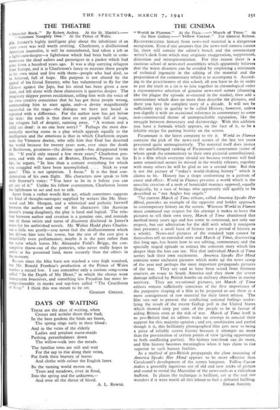THE CINEMA
"World in Flames." At the Plaza.---" March of Time." At
the New Gallery.---6. Yellow Caesar." For General Release. RECONSTRUCTING history from news-reel material is a dangerous occupation. Even if one assumes that the news-reel camera cannot lie, there still remain the editor's bench and the commentary writer's desk from which may originate exaggeration, suppression, distortion and misrepresentation. For this reason there is a cautious school of news-reel assemblers which apparently believes that the worst disasters can be avoided by employing a minimum of technical ingenuity in the editing of the material and the preparation of the commentary which is to accompany it. Accord- ing to the practitioners of this school, all you have to do in order to put the truth in a tin is to join together in chronological order a representative selection of genuine news-reel scenes (shunning like the plague the episode re-enacted in the studio), then add a commentary which does no more than describe the pictures, and there you have the complete story of a decade. It will not be sufficiently epic in quality to be called History, however, unless you dignify it with an occasional reference in commentary to some non-controversial theme of unimpeachable reputation, like the struggle between democracy and dictatorshjp. With this addition you have a formula which appears, on the face of it, to be a reliable recipe for putting history on the screen.
Paramount is the latest company to try it. World in Flames contains the pick of the news-reel scenes of the last ten years presented quite unimaginatively. The material itself does justice to the unchallenged ranking of Paramount's cameramen (some of whom speak the commentary to their own pictorial contributions). It is a film which everyone should see because everyone will find some sensational scenes he missed in the weekly releases, together with many others he will be glad to see a second time. But this is not the picture of "today's world-shaking history" which it claims to be. History has a shape conforming to a pattern of cause and effect: World in Flames presents a world which is the anarchic creation of a mob of homicidal maniacs opposed, equally illogically, by a race of beings who apparently still qualify to be described as "not Angles but angels."
The current March of Time release, called America Speaks Her Mind, provides an example of the opposite and bolder approach to contemporary history on the screen. Whereas World in Flames must command our respect for the attempt it makes to leave the pictures to tell their own story, March of Time abandoned that method many years ago and has come to command, not only our respect, but our admiration for the skill with which it interprets (not presents) a small facet of history (not a period of history as a whole). News-reel pictures of the standard type cannot by themselves tell an extended story and March of Time, discovering this long ago, has learnt how to use editing, commentary and the specially staged episode to extract the coherent story which lies deeper than the lens can see. Not that individual March of Time scenes lack their own excitement. America Speaks Her Mind contains some exclusive pictures which make up the news scoop of the year and perhaps the most important propaganda pictures of the war. They are said to have been seized from German couriers en route to South America and they show the severe damage inflicted by British bombs on military objectives in enemy territory. They are sensational pictures, yet March of Time editors remain sufficiently conscious of the first importance of the purposive shaping of a film to be prepared to use them as a mere consignment of raw material for their latest release. The film sets out to present the conflicting national feelings under- lying the result of the recent Gallup poll in the United States which showed sixty per cent. of the people to be in favour of aiding Britain even at the risk of war. March of Time itself is so pro-British that its editors make no attempt to conceal their support for this majority opinion ; and yet, unobjective and partial though it is, this brilliantly photographed film gets near to being a piece of reliable screen history because it attempts no more than the presentation of certain points of view (giving opportunity to both conflicting parties). No history text-book can do more, and film history becomes meaningless when it lays claim to rise superior to such human frailties.
As a method of pro-British propaganda the close reasoning of America Speaks Her Mind appears to be more effective than Cavalcanti's development of the screen lampoon. Yellow Caesar makes a generally ingenious use of old and new tricks of picture and sound to reveal the Mussolini of the news-reels as a ridiculous buffoon. In places the technique is brilliant, yet at the end one wonders if it were worth all this labour to bait a defeated bullfrog.
EDGAR ANSTEY.






























 Previous page
Previous page